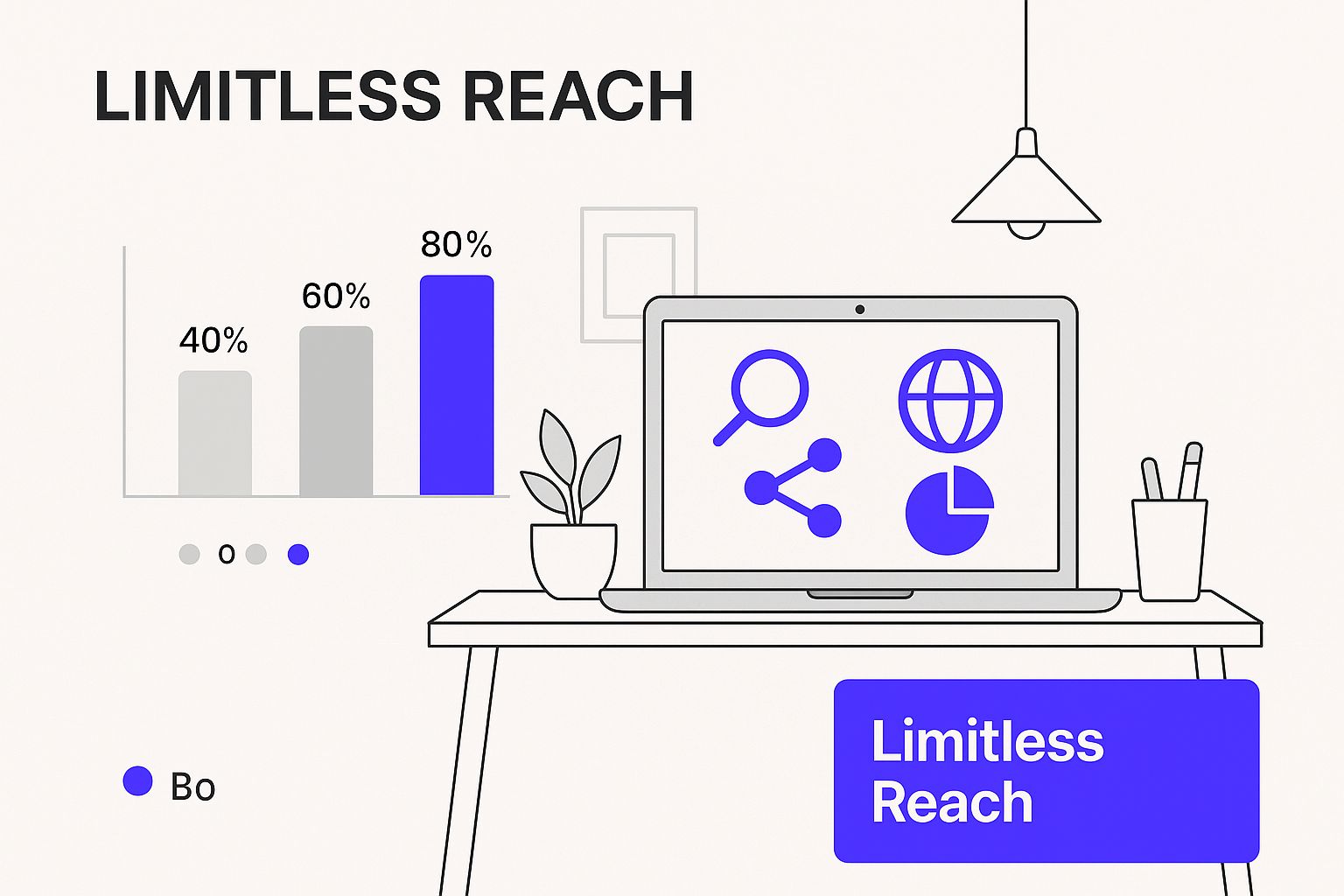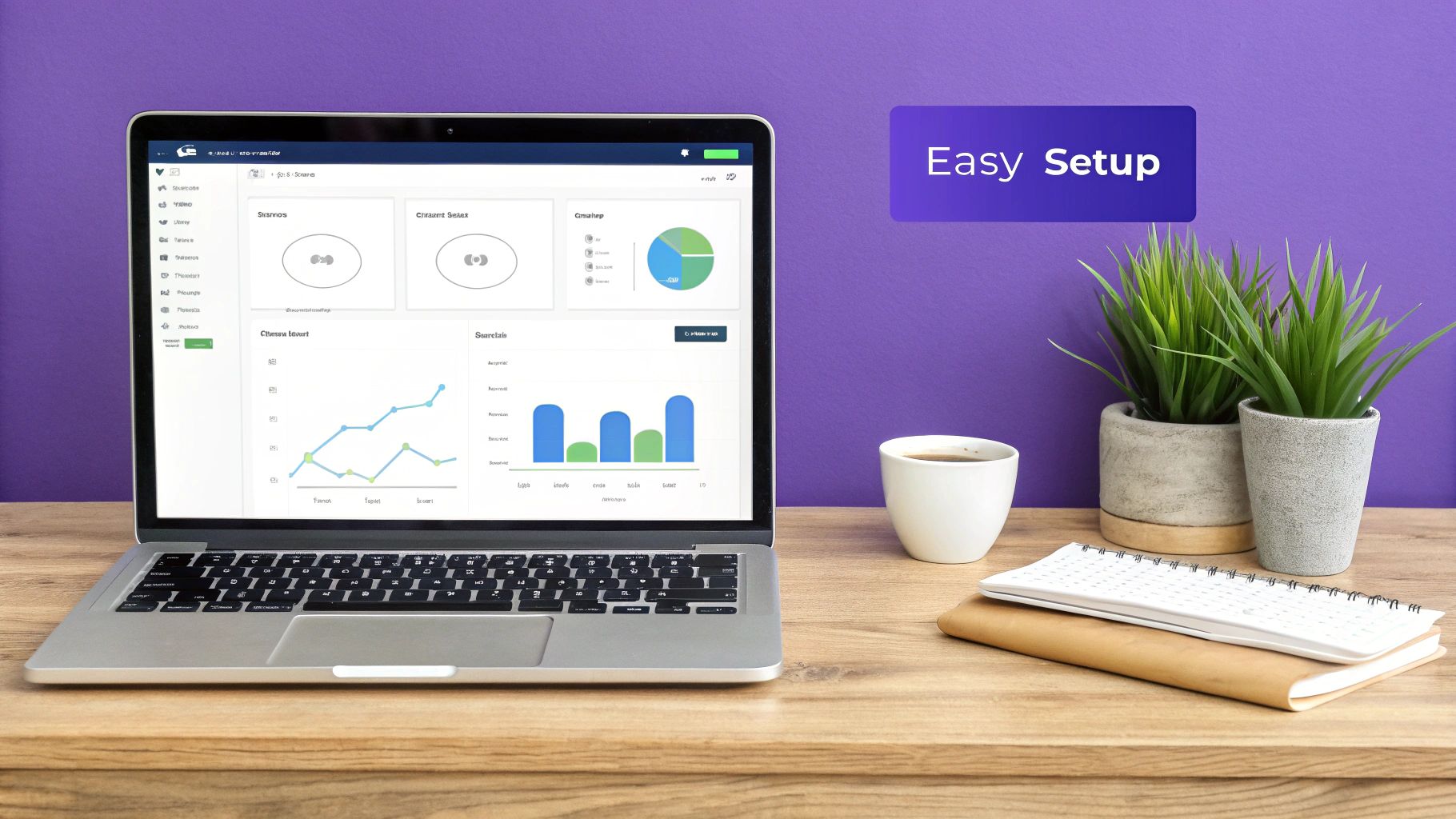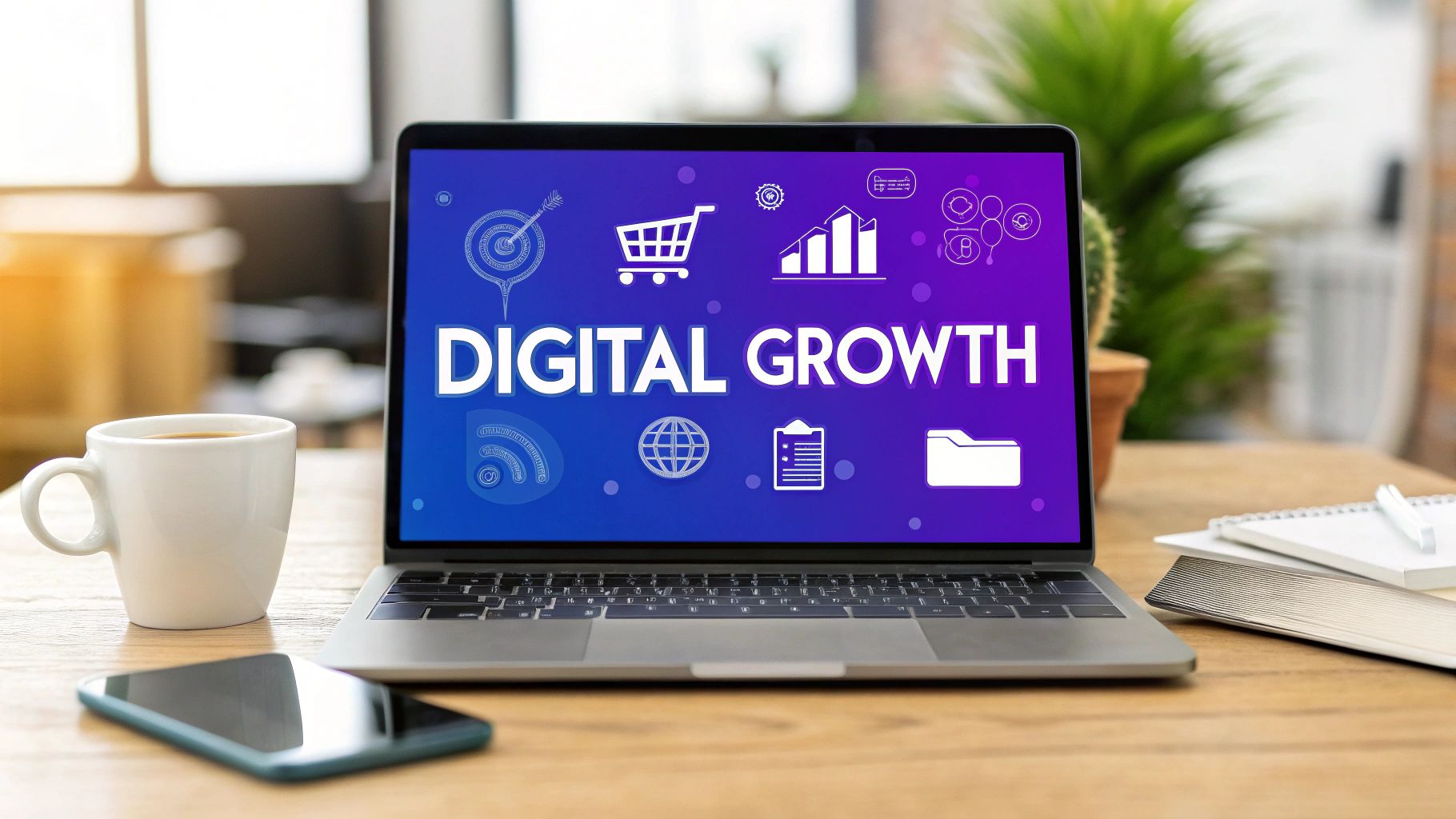Why Digital Products on Shopify Create Sustainable Profit
Selling digital products on Shopify offers a unique approach to sustainable profitability, contrasting sharply with the complexities of managing physical inventory. This model allows you to create a product once and sell it to countless customers without incurring repeated production costs. This eliminates warehousing fees, shipping logistics, and the risk of outdated stock, leading to significantly higher profit margins.
Plus, automated delivery systems work 24/7, sending products to customers immediately after purchase. This frees you to concentrate on other crucial areas of your business.
Reduced Overhead, Increased Scalability
Imagine selling an ebook. Once created, the cost of delivering that ebook to 10 customers is practically identical to delivering it to 10,000. This inherent scalability is a core advantage of digital products. As your audience expands, your profit potential grows exponentially. This differs from physical products, where increased sales often demand higher production and storage expenses. For more insights, check out this helpful guide: How to master selling digital products on Shopify.
The Power of Passive Income
Digital products are perfectly suited for generating passive income streams. A well-designed online course, a collection of design templates, or a subscription-based digital resource can generate revenue continuously. This allows you to build a business that works for you, offering financial freedom and flexibility.
As your digital product business scales, consider specialized hosting like Virtual Private Server (VPS) hosting optimized for e-commerce. This becomes increasingly important as your business expands.
Shopify: A Platform Built for Digital Success
Shopify’s dominance in the e-commerce landscape further amplifies this potential. As of 2025, Shopify supports over 5.23 million active online stores globally, holding a 10.32% global market share and a 29% share in the U.S. (Source).
This enormous user base, combined with Shopify’s intuitive interface and comprehensive app ecosystem, presents a significant opportunity for digital product sellers. The projected $4.8 trillion global e-commerce market in 2025 highlights the vast, untapped market potential. Shopify provides not only a storefront but a complete toolkit for building, marketing, and expanding your digital product business.
The following table illustrates the key distinctions between selling digital and physical products on Shopify.
To help clarify the key differences between selling digital and physical products on Shopify, we've compiled the following comparison:
| Business Aspect | Digital Products | Physical Products |
|---|---|---|
| Inventory Management | No physical inventory | Requires inventory management |
| Production Costs | One-time cost | Recurring production costs |
| Storage & Shipping | No warehousing or shipping costs | Significant warehousing and shipping expenses |
| Scalability | Highly scalable; minimal cost increase with sales volume | Scalability limited by production and storage capacity |
| Profit Margins | Potentially higher due to lower overhead | Potentially lower due to higher overhead |
| Delivery | Instant, automated delivery | Requires shipping and handling |
| Passive Income Potential | High potential for passive income | Limited passive income potential |
In summary, this table highlights the inherent advantages of selling digital products on Shopify. The elimination of physical inventory management, storage, and shipping costs creates opportunities for higher profit margins and easier scalability compared to traditional physical product businesses. The potential for passive income further strengthens the appeal of digital products in the ever-growing e-commerce landscape.
High-Converting Digital Products That Dominate Shopify
Selling digital products on Shopify offers a wealth of opportunities. However, success isn't about selling just any digital product. It's about understanding market trends and pinpointing those high-converting products that resonate with today's consumers. This means prioritizing products with substantial profit potential, manageable competition, and consistent demand.
Uncovering Profitable Niches
The digital product landscape is diverse, encompassing everything from educational resources to creative assets. Some categories consistently outperform others on Shopify. Online courses, for example, are experiencing a surge in popularity. They offer immersive learning experiences and can often command premium prices.
Similarly, digital templates offer tremendous value for busy professionals and entrepreneurs. They provide pre-designed solutions for a wide range of needs, from marketing materials to website design.
Licensed digital content presents another lucrative avenue. Creators of stock photos, videos, music, and sound effects can establish streams of passive income by licensing their work through platforms like Shopify.
Finally, consider the rising demand for subscription-based products. Offering premium content libraries or exclusive memberships cultivates recurring revenue and fosters a loyal customer base. This model essentially builds a community where members pay for access to your valuable resources.

The infographic above visually represents the "Limitless Reach" of digital products, showcasing the immense potential of online sales. It emphasizes the inherent scalability of digital goods – the power to connect with a global audience with minimal overhead, thereby driving growth and maximizing profits.
Validating Your Product Idea
Before committing significant time and resources, validate your product idea. This involves conducting thorough market research to assess demand, analyze the competitive landscape, and anticipate potential obstacles.
Ask yourself key questions. Are there free resources already available covering your chosen topic? If so, how can your product stand out and offer unique value that justifies a purchase? Exploring online communities, forums, and even competitor reviews can provide valuable insights into customer needs and preferences.
Standing Out From the Crowd
Even in a competitive market, you can differentiate your digital product. Prioritize quality, deliver exceptional customer support, and cultivate a strong brand identity that connects with your target audience. Consider offering personalized versions of your templates or creating bundled packages that provide extra value.
Think about how you can customize the customer experience to build loyalty and encourage repeat purchases. Offering bonus content, exclusive access to a community forum, or personalized consultations can distinguish your product and build long-lasting customer relationships. This emphasis on community building and ongoing support can significantly improve conversion rates and contribute to long-term success selling digital products on Shopify.
To further analyze the potential of different digital product categories, consider the following data:
The table below, "Digital Product Categories Performance Analysis," provides data on various digital product categories, including their average profit margins, competition levels, and content creation requirements. This information can help you make informed decisions when choosing your niche.
| Digital Product Type | Avg. Profit Margin | Market Saturation | Creation Complexity | Recommended Pricing Range |
|---|---|---|---|---|
| Online Courses | 60-80% | Medium-High | Medium-High | $49-$999+ |
| Digital Templates | 70-90% | Medium | Low-Medium | $10-$199 |
| Licensed Digital Content | 80-95% | High | Low-High (depending on content type) | $5-$500+ per license |
| Subscription-Based Products | 50-70% | Medium-Low | Medium-High (initial setup, ongoing content) | $9-$99 per month |
This table highlights the potential profitability of different digital product types. While licensed digital content and templates boast high profit margins, online courses offer a wider pricing range, catering to various budget points. Subscription-based products, while having slightly lower margins, offer the advantage of recurring revenue. Choosing the right product depends on your skills, resources, and target market.
Configuring Your Shopify Store for Digital Delivery Excellence
Setting up your Shopify store for selling digital products is key to a smooth operation and happy customers. It all starts with choosing the right Shopify plan, showcasing your products effectively, and ensuring secure, automated delivery. This foundation sets the stage for a successful digital product business.
Choosing the Right Shopify Plan
Shopify offers several different plans, each with its own pricing and features. The Basic Shopify plan often provides a good starting point for selling digital products. As your business grows and your needs evolve, you might consider upgrading to the Shopify or Advanced Shopify plan. These plans offer more advanced features, like professional reports and lower transaction fees. This flexibility lets your store scale alongside your growing customer base and expanding product line.
Formatting and Uploading Your Digital Files
The format of your digital files directly impacts your customer's experience. Choose formats that are widely compatible and provide a good balance between quality and file size. PDFs are a popular choice for ebooks and documents. For audio, MP3 is typically recommended, while MP4 is generally well-suited for video content. Keep your files clearly labeled and organized within Shopify for efficient management. This organization makes it easier for both you and your customers to manage and access purchased files.
Secure Delivery and Download Management
Protecting your digital products from unauthorized sharing is essential. Shopify provides tools and apps to help secure your digital deliveries. Digital Downloads apps offer features like secure download links and limited download attempts, safeguarding your intellectual property. Additional security measures like password protection or PDF stamping can further enhance protection and perceived value for customers. Striking a balance between robust security and user-friendliness encourages repeat purchases.

Automating Your Digital Product Delivery
Automated delivery is a significant benefit of selling digital products on Shopify. Using Shopify's built-in features or dedicated apps, you can set up instant email delivery of download links upon purchase. This immediate access improves customer satisfaction and minimizes support inquiries about delivery delays. Automated systems can also incorporate personalized thank-you messages and product recommendations, fostering engagement and potential future sales. This seamless automated process contributes to a streamlined experience, benefiting both seller and buyer.
Marketing Digital Products When There's Nothing to Touch
Selling digital products on Shopify requires a different strategy than selling physical goods. Because customers can't physically examine your product, building trust and showcasing value are essential. This means using strategies specifically designed for intangible products.
Content Marketing: Showcasing Expertise
Content marketing is a powerful tool. Creating valuable, informative content related to your product's niche establishes you as an expert and builds credibility. For example, if you sell Lightroom presets, create blog posts or tutorials on photo editing techniques. This demonstrates your knowledge and attracts potential customers interested in learning those skills. Want to boost your Shopify sales? Check out this helpful guide: How to master increasing Shopify sales.
This approach not only provides value to your audience but also subtly promotes your products as tools to achieve the results showcased in your content.
Building Trust Through Strategic Sampling
Offering free samples or trials lets potential customers experience your product's value firsthand. This can be crucial for overcoming hesitation about purchasing something intangible. A free chapter of an ebook, a trial version of software, or limited access to premium content can be highly effective. This "try-before-you-buy" approach significantly reduces the perceived risk for the customer.
Irresistible Previews: Overcoming Purchase Hesitation
Compelling previews are essential. High-quality images, engaging videos, and clear descriptions that accurately represent the product's benefits are key. For digital products, the preview becomes the "tangible" stand-in, showcasing the value proposition and encouraging purchases. Think of it as your digital storefront window – make it attractive and informative.
Pricing Psychology and Bundle Offers
Digital products offer pricing flexibility. Value-based pricing, focusing on the perceived value instead of production costs, is a powerful strategy. Creating bundles of related products can increase average order values and provide customers with more comprehensive solutions. This allows you to cater to different customer needs and budgets while maximizing your revenue potential. Want to optimize your Shopify subscription strategy? Explore this guide: Mastering Subscription with Shopify.
Automated Marketing and Shopify Integration
Utilize Shopify’s marketing tools and third-party apps to automate your marketing efforts. Automated email sequences can nurture leads, send personalized product recommendations, and build customer relationships. This automation allows you to focus on product development and other important tasks. Shopify's success, with $7.06 billion in revenue in 2023, growing to $8.88 billion in 2024, and merchants achieving $11.5 billion in sales, demonstrates this growth potential. This is particularly advantageous for digital product sellers due to their scalability and minimal inventory management. Find more detailed statistics here: Shopify Statistics.
By using these targeted marketing strategies, you can effectively position and promote your digital products on Shopify, turning interested browsers into loyal customers and advocates.
Essential Tech Stack for Digital Product Entrepreneurs

Beyond Shopify's core features, a strong tech stack can significantly improve your digital product business. This means choosing the right Shopify apps and integrating external tools to optimize every part of your operation. This section explores essential tools for digital product entrepreneurs selling on Shopify.
Shopify App Ecosystem: Powering Your Digital Store
The Shopify app store offers a wide variety of solutions designed for selling digital products. These apps simplify processes like delivery, customer management, and marketing, letting you focus on creating high-quality products.
Tevello stands out among these solutions as a purpose-built app for selling courses, memberships, and digital products—all directly within your Shopify store. Unlike external platforms, Tevello keeps everything in one place, giving you full control over the customer experience, checkout process, and brand consistency.
While apps like Digital Downloads and Sky Pilot enable secure and automated delivery of digital files, and platforms like SendOwl and Bold Product Options offer features for subscriptions and product bundles, Tevello combines all these capabilities with additional features for online learning and community building. It's a complete digital selling and teaching system designed specifically for Shopify entrepreneurs.
Other platforms like SendOwl and Bold Product Options offer enhanced features for product variations, bundles, and subscriptions, which are crucial for scaling your digital product offerings.
Email Marketing Integration: Building Customer Relationships
Integrating your Shopify store with a robust email marketing platform is essential for nurturing leads and encouraging repeat business. This integration allows you to automate email campaigns, send personalized product recommendations, and manage post-purchase follow-ups. This all contributes to building stronger customer relationships.
Connecting with platforms like Klaviyo or Mailchimp can automate welcome emails, deliver lead magnets, and segment your audience for targeted campaigns. This direct communication channel builds customer loyalty and encourages repeat purchases.
Membership and Learning Management Software
If you offer courses or memberships as digital products, consider integrating with platforms that specialize in online learning. Tools like Thinkific, Teachable, and Podia provide external hosting environments for courses - but they often require separate logins, complex integrations, and send your customers away from your Shopify store.
With Tevello, you don’t have to send customers elsewhere. You can create, sell, and deliver courses, digital content, and memberships—all within Shopify. Tevello’s built-in LMS features and community tools let you manage lessons, track progress, and interact with learners without ever leaving your store. This streamlined, all-in-one experience improves conversion rates, simplifies fulfillment, and keeps your brand front and center.
Analytics and Optimization: Understanding Your Customers
Using analytics tools is essential for optimizing your digital products and marketing strategies. Shopify's built-in analytics provides a basic overview of sales and traffic. However, integrating with Google Analytics offers a more detailed understanding of customer behavior. This includes insights into traffic sources, conversion rates, and popular products. This information lets you refine your marketing efforts, improve product offerings, and maximize your ROI.
Choosing the Right Tech Stack for Your Business
The ideal tech stack depends on factors like your product type, budget, and business goals. For example, a creator selling individual digital downloads may need a simpler setup than someone offering subscription-based premium content or online courses.
Start with the essential tools and gradually add more advanced solutions as your business expands and your needs change. This strategic approach ensures your tech stack stays aligned with your growth trajectory and maximizes efficiency at each stage. By carefully choosing and integrating the right tools, you can create a powerful system for selling digital products on Shopify, leading to increased efficiency, higher conversions, and sustainable growth.
Scaling Your Digital Product Empire Beyond First Sales
Selling your first digital products on Shopify is a major milestone. But building a truly successful, sustainable business means scaling beyond those initial sales. This requires strategic expansion, diversification, and a laser focus on customer lifetime value. Let's explore some key strategies for scaling your digital product business on Shopify.
Diversifying Your Product Portfolio
Expanding your product offerings is essential for long-term growth. Vertical expansion means creating products that complement your existing ones, catering to deeper customer needs. For instance, if you sell a beginner's photography guide, you could develop an advanced course on portrait photography or offer a collection of Lightroom presets.
Horizontal expansion broadens your product range to address different, but related, customer needs. You could add a video editing course for photographers or branch into graphic design templates. This opens new market segments and diversifies income streams. For more ideas, check out this resource: Digital Product Business Ideas.
Building a Product Ecosystem
A product ecosystem interconnects your offerings to boost customer lifetime value. This could involve product bundles, tiered memberships, or a subscription service with ongoing access to new content and updates. This builds a loyal customer base and generates recurring revenue. Think of it like a membership site packed with related digital products, enhancing the customer experience and deepening brand engagement.
Recurring Revenue Models: The Engine of Growth
Recurring revenue models are crucial for predictable income and sustainable scaling. Consider subscriptions for content libraries, online communities, software access, or ongoing support. This model's predictability allows for better forecasting and planning. It also strengthens customer relationships, increasing their lifetime value and fostering a sense of community.
Leveraging Customer Feedback: The Key to Improvement
Actively seeking and using customer feedback is vital for continuous improvement. Feedback offers invaluable insights into what your audience wants and how you can enhance your products. Integrate a feedback system into your Shopify store to collect valuable data for product development and marketing.
Strategic Partnerships: Expanding Your Reach
Strategic partnerships can significantly expand your reach and introduce you to new customers. Collaborate with influencers in your niche, partner with complementary businesses, or integrate your products into existing online communities.
Building a Team and Automating Processes
As your business expands, building a team becomes essential. Hire customer support reps, marketing specialists, or virtual assistants. Automation is key to efficient growth management. Automate email marketing, social media posting, and customer onboarding. This streamlines operations, letting you focus on strategic expansion.
Protecting Your Digital Products
Protecting your intellectual property is paramount. Implement strategies to prevent unauthorized sharing and safeguard your digital assets. Consider using digital rights management (DRM) software, limiting download attempts, or watermarking content.
By using these strategies, you can effectively scale your digital product business on Shopify and create a sustainable, profitable online empire.
Ready to Grow Your Digital Product Sales?
Selling digital products on Shopify is easier and more powerful with Tevello. Whether you're offering courses, downloads, or memberships, Tevello lets you do it all directly within your store—no extra platforms, no redirects.
✔ Sell and deliver digital products
✔ Create courses and communities
✔ Bundle physical + digital items
✔ Keep everything under one roof
Start your free trial today and start building your thriving digital product business on Shopify today! Learn more about Tevello and see how we can help you create and sell courses within your Shopify store.




